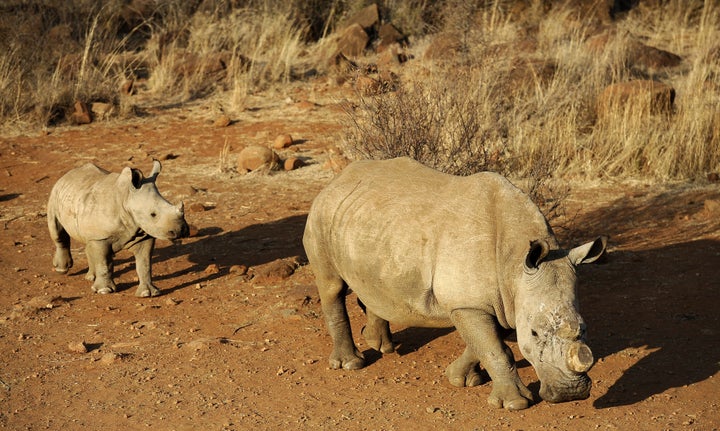Anti-poaching activists have tried a number of ways to save rhinos. They've dyed the animals' horns with a bright pink solution poisonous to humans. Drones have been deployed to protect the creatures. Some even live under 24-hour armed guard. But the slaughter just won't stop.
Now, a nonprofit has an innovative new solution to try to curb poachers, who killed a record 1,215 rhinos in South Africa last year. Protect, a British conservation group, has developed a technology system, which includes a camera embedded in an animal's horn and heart rate monitors, that allows rangers to track the health of the rhinos they're guarding from afar.
If an animal becomes stressed, which scientists can find out via their heart rate, a camera embedded in the horn and a GPS tracker can be remotely activated to gauge whether the rhino is in danger. Guards can then respond immediately to help save an injured animal.
"With this device, the heart rate monitor triggers the alarm the instant a poaching event occurs, pinpointing the location within a few meters so that rangers can be on the scene via helicopter or truck within minutes," Paul O'Donoghue, chief scientific adviser for Protect, said in a statement. "[This leaves] poachers no time to harvest the valuable parts of an animal or make good an escape. You can't outrun a helicopter."

Some drastic measures taken to protect rhinos from poaching include dehorning. But the process needs to be repeated every few years after the horns grow back.
South Africa is home to some 20,700 rhinos, the bulk of the world's population. Poachers are already on track to kill more of them this year than ever, set on an easy payday that can net upward of $75,000 per kilogram of illicit horn. Ground-up horn is a highly sought-after folk remedy in some Asian countries, despite holding zero medicinal benefit. The animal part is actually made of keratin, the same protein found in human fingernails.
One of the major drawbacks of many anti-poaching measures, which also include traditional dehorning, is the sedation necessary to carry out the procedures. Some rhinos simply don't survive tranquilization, and an animal died during a demonstration in 2012.
Protect, which didn't respond to a request for comment, has said it plans to widely deploy the system -- called the Real-time Anti-Poaching Intelligence Device, or RAPID -- sometime in 2016. "The figures make it painfully clear; there is no time to waste, the tide has to be turned," said Steve Piper, a director of the nonprofit. "The only thing heading for extinction over the next decade is poaching itself."
The Verge notes the group even points to the potential application in other endangered species, including elephants and tigers.
